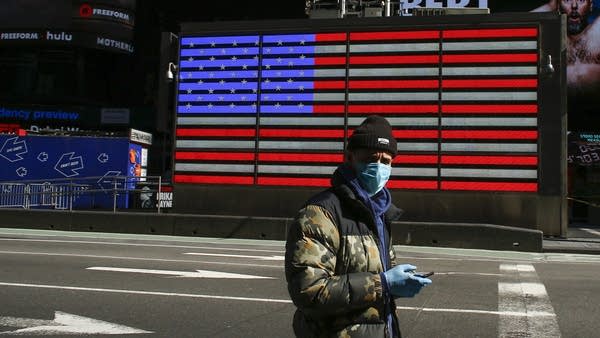How looking back at the Fed’s past can help us understand its future
Former Federal Reserve chairman Ben Bernanke’s new book charts a history of “remarkable innovation and change.”

The Federal Reserve is currently attempting to rein in the highest inflation since the 1970s without tipping the U.S. economy into recession. It’s the latest in an unprecedented series of challenges for the 108-year-old institution.
“I’ve always thought that looking at economic history was the best way to get clues about how to deal with the current situation,” said former Federal Reserve Chairman Ben Bernanke in an interview with “Marketplace” host Kai Ryssdal.
In a new book, “21st Century Monetary Policy: The Federal Reserve from the Great Inflation to COVID-19,” Bernanke explores the Fed’s recent history, one “defined by remarkable innovation and change.”
To listen to Marketplace’s interview with Bernanke, click here. The following is an excerpt from Bernanke’s book.
On January 29, 2020, Jay Powell strode briskly to the podium to begin the first press conference of his third year as chair of the Federal Reserve. He flipped open a white binder, looked up briefly to welcome the assembled reporters, and then looked down to read his prepared statement. His demeanor was low-key, almost somber. But his message was upbeat: The U.S. economy had entered the eleventh year of a record-long expansion, unemployment remained at a half-century low, and people in lower-paying jobs were seeing wage gains after years of stagnation. The trade tensions that had roiled financial markets for the past two years had diminished and global growth seemed to be stabilizing.

In passing, he noted “uncertainties” affecting the economic outlook, “including those posed by the new coronavirus.” A follow-up question on the virus, from Donna Borak of CNN, did not come until 21 minutes into the 54-minute press conference. At that point, only a few cases had been reported outside China. The virus, Powell cautiously acknowledged, was “a very serious issue” that could cause “some disruption to activity in China and possibly globally.”
Five weeks later, on March 3, Powell walked to the same podium and in the same calm tone read a much darker statement to reporters. He offered his sympathy to people the virus had harmed around the world, noted that it had disrupted the economies of many countries, and predicted that measures to contain the virus “will surely weigh on economic activity both here and abroad for some time.” The Fed, he said, was cutting interest rates “to help the economy keep strong in the face of new risks.” He hinted at more to come. The state of the world had changed dramatically—and the Fed’s policy had changed with it.
Between the January 29 and March 3 press conferences, the virus had evolved from a localized problem to an incipient global crisis. Reported cases of the disease that would become known as COVID-19 had risen from fewer than 10,000, almost all in China, to more than 90,000 worldwide. Italy had quarantined towns in its Lombardy region and Iran had reported a surge of infections. In the United States, the first virus death was reported on February 29—a man in his 50s, near Seattle. U.S. cases, and deaths, grew exponentially from there, threatening to overwhelm health-care systems in New York City and other hot spots.
Meanwhile, virus fears triggered the worst week in U.S. financial markets since the 2007–2009 financial crisis, signaling trouble ahead for the economy. The Dow Jones Industrial Average, which had hit a record high earlier in the month, plunged more than 12% during the week ending February 28. In March the turmoil spread to bond markets. Sellers of even ultrasafe U.S. Treasury securities had difficulty finding buyers, who showed little interest in holding anything other than cash. The markets for private credit, where corporations, home buyers, and state and local governments borrow, threatened to freeze entirely as lenders and investors grappled with coronavirus-induced uncertainty.
The market’s panic attack did, in fact, presage economic trauma. With businesses and schools closing, either voluntarily or under lockdowns imposed by local governments, economic activity contracted at an unprecedented rate. In February 2020, following a long recovery from the Great Recession, only 3.5% of the labor force was unemployed. Two months later, in April, the official unemployment rate stood at 14.8%, a shocking increase that likely understated the damage to the labor market. More than 20 million jobs were lost in April, by far the largest drop recorded since the data series began in 1939. The Business Cycle Dating Committee of the National Bureau of Economic Research, the arbiter of the timing of recessions and expansions, would later date the start of the pandemic recession to February.
Having served as Fed chair during the 2007–2009 global financial crisis, I had some idea of the stress that Powell and his colleagues at the Fed were experiencing. But, unlike the crisis we faced a dozen years earlier—which played out over nearly two years—this one seemed to happen all at once. On the principle that it’s better to get ahead of a crisis when you can, the Powell Fed quickly took a remarkable range of actions to calm the financial turmoil and protect the economy. It took its short-term interest rate target close to zero and promised to hold it there for as long as needed. To help restore normal functioning in money markets and Treasury debt markets, it lent to cash-strapped financial firms and bought hundreds of billions of dollars worth of Treasury and mortgage-backed securities on the open market. It reinstituted financial crisis-era programs to support business and consumer credit markets. Working with foreign central banks, it ensured global markets an adequate supply of dollars, the world’s reserve currency. And it would ultimately promise to continue its large-scale purchases of securities—a policy known as quantitative easing—until economic conditions improved substantially.
“Monetary policy is not a panacea. But money matters—a great deal” – Ben Bernanke
All of those measures were drawn from a playbook developed during the 2007–2009 crisis. But the Powell Fed did not stop there. It worked with Congress and the Treasury Department to establish new programs to backstop corporate and municipal bond markets and to finance bank loans to medium-sized businesses and nonprofit organizations. And in August 2020 it announced important changes to its monetary policymaking framework—the outcome of a process begun before the pandemic struck—aimed at making policy more powerful when interest rates are already low. In the ensuing months, it fleshed out its monetary approach by making more explicit its promises to keep interest rates low for as long as needed.
Of course, the Federal Reserve could do nothing to affect the course of the virus, the ultimate source of the crisis. Nor could it tax and spend to support the people and businesses most affected by the disease, as the administration and Congress could. But it could use both monetary policy and its lending powers to provide stability to the financial system, smooth the flow of credit to the economy, support consumer and business spending, and promote job creation. In doing so, it would play a substantial role in bridging the economy to the recovery that would follow the pandemic.
As I often remarked when I led the Fed, monetary policy is not a panacea. But money matters—a great deal. And, as the responses of the Powell Fed to the pandemic illustrate, monetary policy in the 21st century—and central banking more generally—has been defined by remarkable innovation and change. The Fed’s varied and sweeping actions during the pandemic, and the speed at which they were decided upon and announced, once would have seemed inconceivable—not only to the Fed of the 1950s and 1960s, chaired by the first modern Fed leader, William McChesney Martin Jr., but even to the Fed of the 1990s, led by one of history’s most influential central bankers, Alan Greenspan. As Powell himself would acknowledge, “We crossed a lot of red lines that had not been crossed before.”
The aim of this book is to help readers understand how the Federal Reserve, the steward of U.S. monetary policy, got to where it is today, what it has learned from the diverse challenges it has faced, and how it may evolve in the future. Although my account focuses on the Fed, the central bank I know best, I also draw on the experiences of other major central banks, which have faced many of the same challenges and have made important innovations of their own. I hope this book will be useful to my fellow economists and their students, but I have tried to make it accessible to anyone with an interest in economic policy, finance, or central banking. As the role played by the Powell Fed in the pandemic crisis makes clear, an appreciation of the goals of the Federal Reserve, and of the tools and strategies it uses to meet those goals, is essential for understanding the contemporary global economy.
Excerpted from 21st Century Monetary Policy: The Federal Reserve from the Great Inflation to COVID-19. Copyright © 2022 by Ben S. Bernanke. Used with permission of the publisher, W. W. Norton & Company, Inc. All rights reserved.













